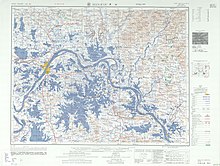Han-k'ou
Appearance
English
[edit]
Etymology
[edit]From the Wade–Giles romanization of the Mandarin 漢口 (Han⁴-kʻou³).[1]
Proper noun
[edit]Han-k'ou
- Alternative form of Hankou
- 1912, Arthur Henderson Smith, “A General View of China”, in The Uplift of China[1], →OCLC, page 5:
- The Yang-tzŭ, which is 60 miles wide at its mouth, with its numerous tributaries is to China what the Mississippi and Amazon are to the United States and South America. It is navigable by large oceans streamers to Han-kʻou, more than 600 miles from its mouth.
- 1978, Arthur F. Wright, The Sui Dynasty[2], New York: Alfred A. Knopf, →ISBN, →LCCN, →OCLC, pages 140–141:
- Further to the east was the strategic Han River, flowing from the northwest to the southeast and entering the great river, as it still does, at Han-k'ou, "the Han's mouth."
- 2006, Michael Calvert, edited by Jon E. Lewis, Shanghai (1937) (The Giant Book of Battles)[3], London: Magpie Books, →ISBN, page 128:
- The Western admirals decided to ignore the threat and stay put, but arrangements were made to move all Europeans up-rive for evacuation to Canton and Hong Kong, via the newly completed Han-k'ou (Hankow)-Canton railway. Capetown actually left Nanking on 21 September with a large contingent of refugees for Han-k'ou and only just missed the heavy bombing of the capital the following day.
- For more quotations using this term, see Citations:Han-k'ou.
Translations
[edit]Hankou — see Hankou
References
[edit]- ^ Hankou, Wade-Giles romanization Han-k’ou, in Encyclopædia Britannica
Further reading
[edit]- “Han-k'ou”, in Collins English Dictionary.
- “Han-k'ou” in TheFreeDictionary.com, Huntingdon Valley, Pa.: Farlex, Inc., 2003–2025.
